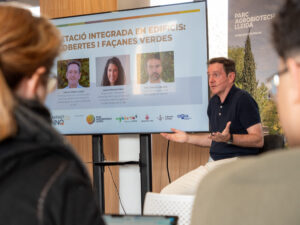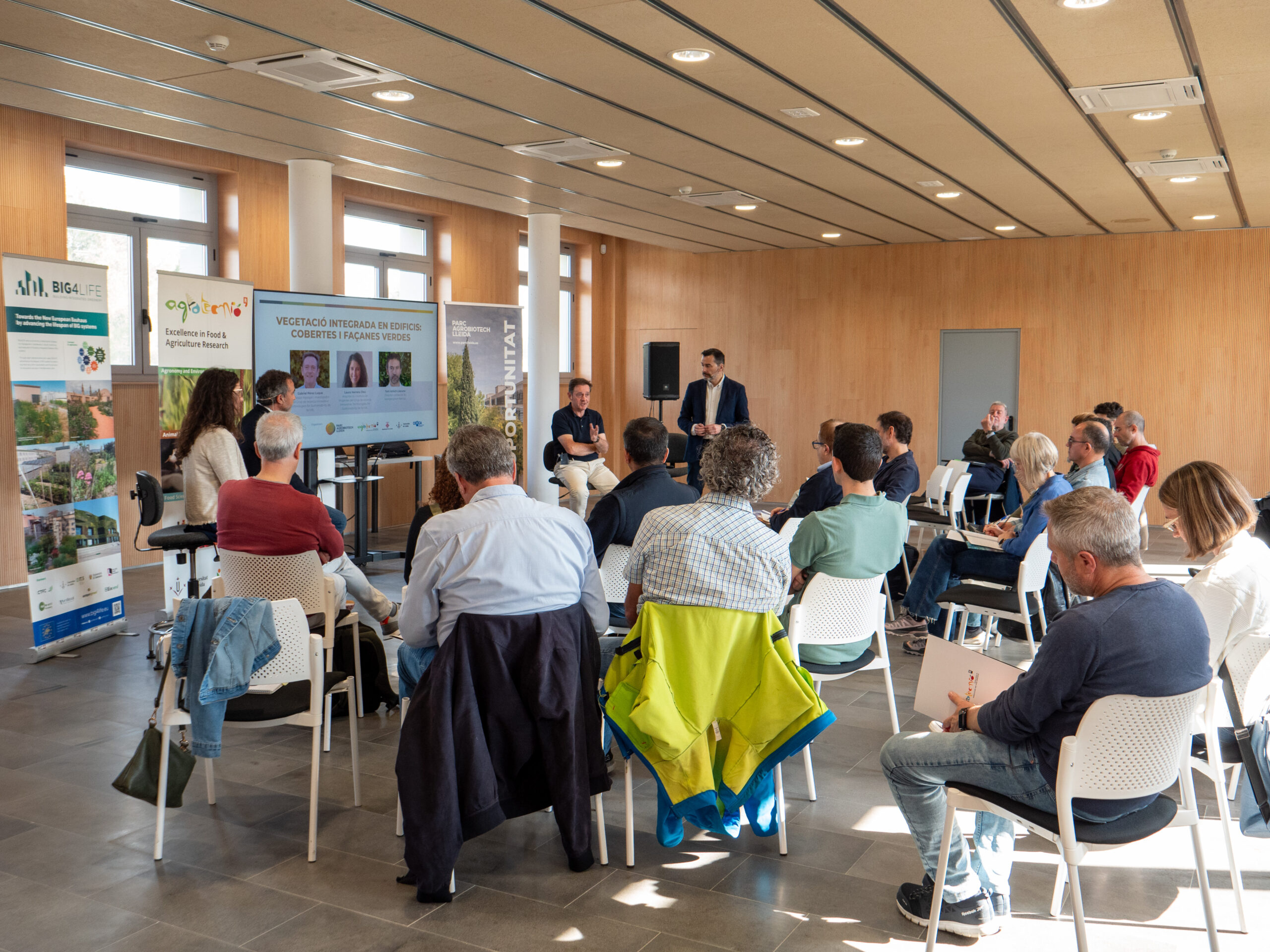
- The benefits of using green roofs and walls to re-naturalize urban spaces are the focus of the new Breakfast4Inno innovation breakfast
- The University of Lleida leads research in Spain on the green transformation of cities
The benefits of using green walls and roofs on buildings were the focus of the latest Breakfast4Inno innovation breakfast, organized monthly by Agrotecnio and the Agrobiotech Park. The University of Lleida (UdL) is a leader in Spain in research aimed at promoting urban re-naturalization through the integration of vegetation in buildings. Green walls and roofs, known as BIG systems (Building Integrated Greenery), are solutions that offer multiple environmental, social, and economic benefits.
These green infrastructures contribute to thermal and acoustic insulation, improve air quality, reduce the urban heat island effect, absorb CO₂, and promote biodiversity. In addition, they bring well-being to people through contact with nature and the aesthetic enhancement of spaces.
During the session, Professor Gabriel Pérez Luque, researcher from the Innovative Technologies for Sustainability group at UdL, explained that “green roofs are here to stay, they are not a trend.” Pérez Luque detailed all their advantages, which include thermal and acoustic regulation of the building, protection of insulation systems, aesthetic improvement, reduction of city temperatures, and urban drainage control, among others. According to the researcher, “green walls and roofs can produce energy savings in building cooling of between 30 and 60%, respectively.”
Despite all these benefits, there are still challenges to be addressed, such as that “the installation and maintenance of these solutions require initial investments and continuous technical monitoring to ensure their effectiveness and durability,” he stated.
The UdL has been working for over a decade on the development of green systems, focusing on energy savings, acoustic comfort, and the use of sustainable materials.
The BIG4LIFE Project
The University of Lleida leads and coordinates the European project BIG4LIFE, which promotes the transition of the construction sector toward a more sustainable, circular, toxic-free, energy-efficient, and climate-resilient model.
The project, funded by the European Union, aims to integrate vegetation into urban buildings through collaborative maintenance and monitoring strategies. With a budget of over 1.8 million euros, BIG4LIFE is implementing sustainable gardening solutions in Lleida, El Prat de Llobregat, and Barcelona, with replications also in Genova and Athens. The projects include the rehabilitation of green roofs on municipal buildings and schools, as well as the installation of green walls in amusement parks.
Launched in 2023, the project will continue through 2026 and aims to ensure the sustainability and economic viability of these integrated green systems. According to Laura Herrera Díez, architect and project manager of the same UdL research group, “through this research, we aim to improve ecosystem services such as air quality, energy savings, and biodiversity.”
The project involves eight European entities, including universities, research centers, and specialized companies from Spain, Italy, the Netherlands, and Greece: the Forest Science and Technology Centre of Catalonia (CTFC), the University of Genoa (UNIGE), the Hellenic Open University (HOU), TEB Verd SCCL, Verdtical Ecosistema, Solucions Eixverd, and Sempergreen BV.
Currently, BIG4LIFE’s efforts are focused on overcoming barriers such as cost, lack of specialized technical training, and biophobia (aversion to natural elements in built environments). In addition, the development of smart systems is being promoted to automatically control variables such as humidity and temperature.
BIG4LIFE advocates for a participatory approach, through Community Service Learning programs and outreach activities to engage citizens in the transformation of their surroundings.
With the BIG4LIFE project, the University of Lleida is leading a shift toward greener, more resilient, and healthier cities, where nature and technological innovation go hand in hand to build a better future.
Success stories
The event showcased local and international success stories, such as part of the green roof of the H buildings at the Agrobiotech Park in Lleida, the roof of the Bressol Ronda La Mercè School in Lleida, as well as the landscaped façade of the Tibidabo Park, among others from around the world.
The sales director of Sempergreen –one of the partners in the BIG4LIFE project– presented cases in countries such as Germany, France, and Italy, where these solutions are promoted by administrations. Toni Amich encouraged public administrations to support these systems in order to later incentivize private installations: “In the Netherlands, for example, there are nearly 100 municipalities that offer direct subsidies to individuals who install a green roof on their building.”
This Dutch-based company is a benchmark in the production of green roofs and walls, selling more than 2.5 million square meters throughout Europe. With over 20 years of experience, Sempergreen is committed to modular, lightweight, and sustainable systems, such as detention roofs for rainwater management and new solar green roofs, which combine energy efficiency with landscape integration.

